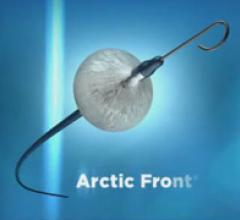May 17, 2010 – New STOP AF (Sustained Treatment of Paroxysmal Atrial Fibrillation) clinical trial data showing the number of paroxysmal atrial fibrillation (AF) patients reporting AF symptoms declined by 80 percent after treatment with the Arctic Front Cardiac CryoAblation Catheter System.
May 14, 2010 – New evidence demonstrates key shock-reduction programming strategies significantly reduced implantable cardioverter-defibrillator (ICD) and cardiac resynchronization therapy defibrillator (CRT-D) shocks from 17 to 28 percent. The study also identified programming and patient characteristics that increased the risk of shocks.
May 14, 2010 — A partnership to develop cardiovascular genomic diagnostic testing devices has been signed between GE Healthcare and CardioDx.
Providing exceptional cardiovascular care for patients to achieve the best possible outcomes is the number one goal for ...
May 14, 2010 – Research published in the April issue of The Journal of Simulation in Healthcare demonstrates the potential for high-fidelity simulations in assessing the performance of interventional cardiologists.

A quick look at the current statistics sends an alarming message: The state of cardiovascular health in the United States is abysmal. With diabetes and obesity on the rise, we as physicians need to take the lead to help the U.S. population manage its increasing risk for developing cardiovascular-related disease.
May 13, 2010 – An easy-to-wear, single-use, continuous ambulatory cardiac rhythm monitor yields high-quality diagnostic information, while providing greater patient comfort and improved compliance. The U.S. Food and Drug Administration (FDA) recently cleared the Zio Patch.
Cardiac positron emission tomography (PET) is growing in popularity among cardiologists because it provides the ability ...
May 13, 2010 – The U.S. Food and Drug Administration (FDA) has cleared a small pacemaker with integrated, wireless, remote monitoring capabilities. The Evia pacemaker is 20 percent smaller than previously released Biotronik pacemakers.
May 13, 2010 – An integrated, break-away hemostasis valve is integrated into a new lead delivery system is designed to minimize blood loss and allow for easier implantation. The U.S.
May 13, 2010 – A new simulation system to augment traditional procedural training for physicians on laser-assisted lead extraction procedures permits hands-on practice with extraction tools in a virtual environment. Spectranetics Corp. introduced its Laser Lead Extraction Simulation system at the Heart Rhythm Society’s (HRS) 31st Annual Scientific Sessions this week in Denver.
When performing radiofrequency (RF) ablation to treat cardiac arrhythmia, medical professionals must balance the safety ...
May 12, 2010 – The U.S. Food and Drug Administration (FDA) cleared the way for a clinical trial to evaluate the safety and effectiveness of the Misago self-expanding stent for use in the superficial femoral artery (SFA).
May 12, 2010 – The Japanese Ministry of Health, Labor and Welfare (MHLW) today cleared the AnalyST implantable cardioverter defibrillator (ICD) with ST-monitoring in Japan. The device continuously monitors ST segments as an early warning system for cardiac problems.
May 12, 2010 – A new feature of a magnetic navigation platform facilitates remote manipulation of diagnostic devices used during electrophysiology (EP) procedures. Stereotaxis Inc. is introducing the Vdrive this week at the Heart Rhythm Society annual meeting. The device enables the electrophysiologist to fully and remotely control diagnostic catheters and accessories.
Change Healthcare Cardiology Hemodynamics is an integrated hemodynamic monitoring system for monitoring vital signs and ...
May 12, 2010 – A paclitaxel-eluting coronary stent received CE mark approval for a specific indication to treat diabetic patients. The Taxus Element incorporates a platinum chromium alloy and a new stent design. The Boston Scientific plans to launch the stent in June in the European Union and other CE mark countries.

A quiet revolution is going on in the world of patient risk stratification. It is becoming increasingly apparent that, while sudden cardiac death (SCD) manifests in the heart, it is triggered by the brain via the autonomic nervous system (ANS). Techniques taking this into account have the potential to be far more accurate and robust than other existing methods.

The importance of dealing with the epidemic of coronary artery disease (CAD) is well known, and the tools at our disposal to accurately recognize and manage it are evolving in very positive ways.


 May 16, 2010
May 16, 2010









